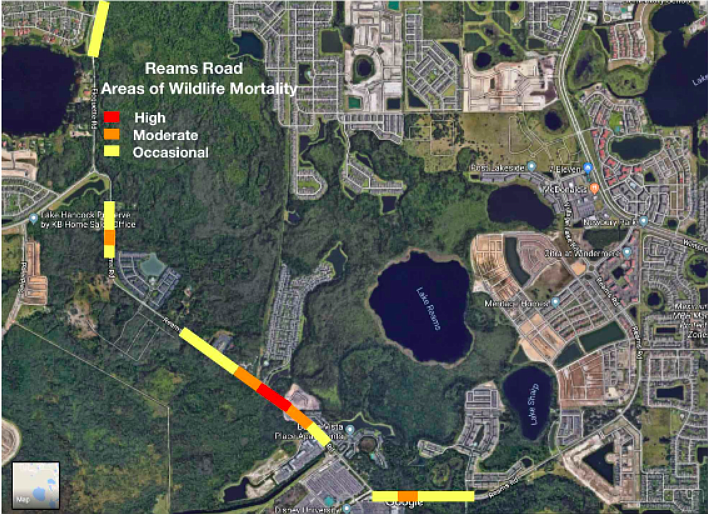- April 17, 2024
-
-
Loading

Loading

An environmental organization is demanding Orange County take more action to address the wildlife mortality rates on a stretch of Reams Road its leaders believe has an extremely high rate of roadkill.
Noahs’s Notes makes it its mission to preserve wildlife and wildlife habitats. Since 2015, it has taken it upon itself to track the rate of wildlife that is struck and killed on Reams Road on an annual basis.
The nonprofit, headed by certified state master naturalist and environmental consultant Don Kendzior, began monitoring these rates in 2015 after Horizon West residents and Disney cast members who regularly commute Reams began reporting wildlife being struck and killed in the vicinity of the existing pipe culvert on Reams, Kendzior said.
The reports caught Kendzior’s attention because water levels in the conservation areas north of Reams Road were observed to be regularly above seasonal norms at the time, and Kendzior doubted it was a coincidence. He believes development has forced wildlife into a smaller and smaller area and increased water levels are forcing animals to go over Reams Road at the point of the box culvert.
Orange County officials said it does not track wildlife mortality rates, but the nonprofit’s ongoing monitoring efforts have revealed that about 400 animals have been killed from 2015 to 2018 on that stretch of Reams Road near the existing pipe culvert. Half of those deaths occurred in the area between Greenbank Boulevard and Peachtree Park Court, he said.
From January to February of this year, 11 animals have been struck and killed — a rate of one animal every 3.4 days, Kendzior said. To date, he has documented 16 species of wildlife that have been killed on Reams. Some animals have been too mutilated from vehicle impacts to be recognizable, he said.
“Entire families of animals, like otters, have been killed, and this mortality rate is unsustainable for (the) area’s wildlife populations,” he said. “One endangered species — a gopher tortoise — and one threatened species — a pair of sandhill cranes — were killed last year.”
Kendzior believes such statistics are alarming and unsustainable, and that more should be done to mitigate the issue.
According to a report emailed to Orange County summarizing the data, his nonprofit requested that immediate action be taken while the county works on its Reams Road widening project.
“(Because) there has been no significant decrease in wildlife mortality and minimal action was taken in 2018, we have asked the county to present a list of additional actions that may be implemented in the interim before adequate wildlife crossing infrastructure is in place with the new roadway in 2025,” he said.
Some suggestions Kendzior proposed in the report included:
Although the latest suggestions have not yet been evaluated for feasibility by county staff, other measures have been taken in response to Kendzior’s observations and concerns, said Diana Dethlefs, aide to Orange County District 1 Commissioner Betsy VanderLey.
VanderLey emphasized that she does not support any suggested actions that only would provide temporary solutions while resulting in a construction delay of the coming improvements for Reams Road — one of which should provide a permanent solution to the issue, she said.
“I’ve made it clear to Mr. Kendzior that I’m unwilling to do anything that would either detract from the budget of the permanent fix or slow down the permanent fix,” VanderLey said. “But we’re willing to look at actions we could possibly take that would mitigate without hitting the budget or incurring delays for the permanent fix.
“But ultimately, the problem needs the permanent fix, which is the roadway widening, the sidewalks on the roadway, and the culvert underneath the road for animals to be able to migrate. It needs that, and I'm not going to slow it down. And so the concern that I have with his requests is that a number of his requests would impact the budget and the schedule. And I just think it's shortsighted to do that.”
VanderLey added that while the roadway design was underway, the county took a number of measures in response to the nonprofit’s concerns. To date, it has
But VanderLey noted that even the wildlife corridors may not result in a complete solution, because it depends on the animals’ behavior as well.
“We've been pretty creative in making sure that we're doing what we can while not slowing down the ultimate fix,” she said. “We're going to provide a culvert for the animals when we improve the road, but we have no way of making sure the animals use that. So we're hoping that they use that safe way to cross the road, but that's not to say that there won't be roadkill here ever again. We'll provide what we can in order to balance the interests of people and the animals, but we don't control the behavior of either, frankly.”